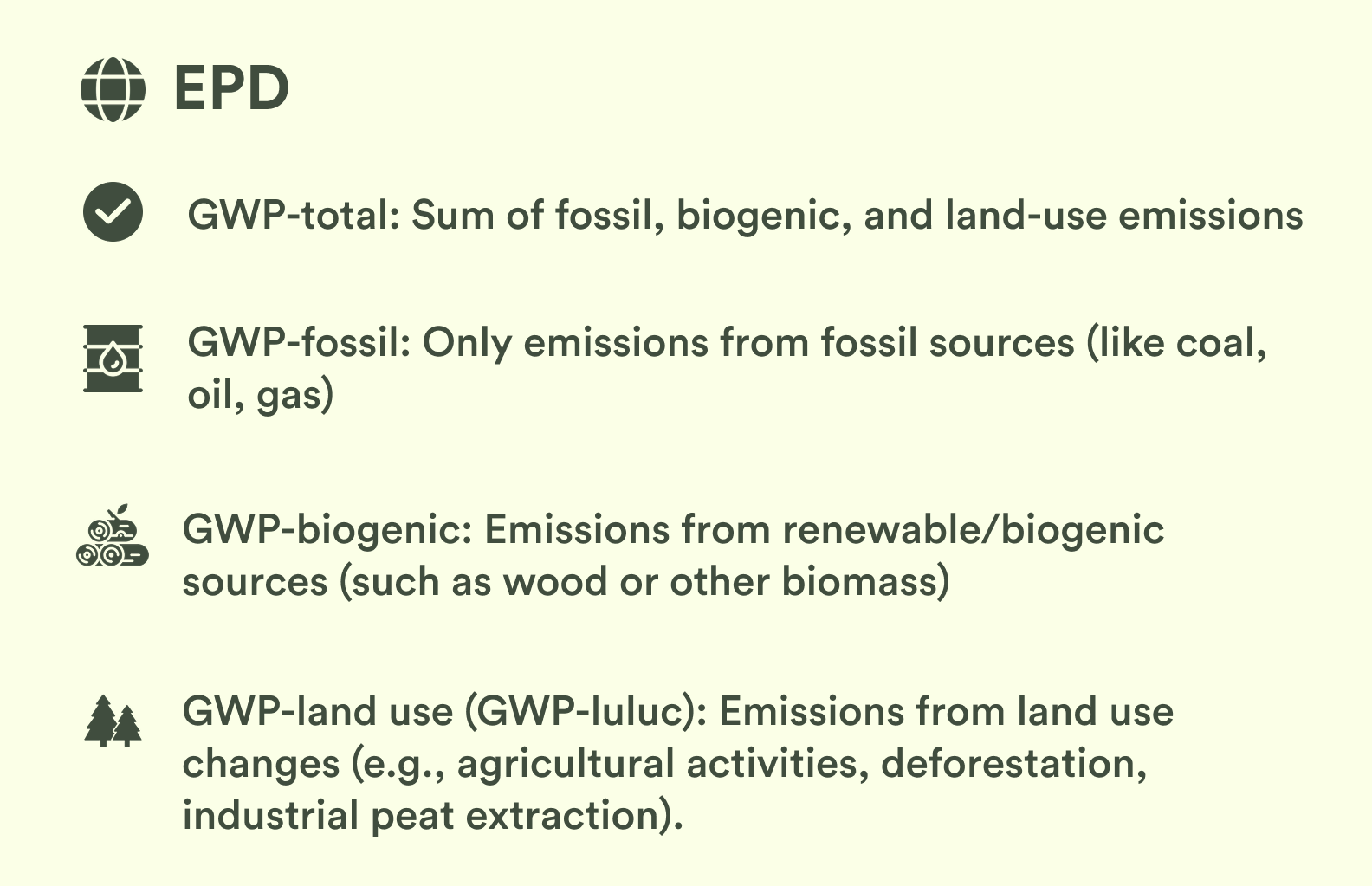Gross vs Net GWP in EPDs: Understanding the Difference
- Gross and net GWP values reflect different accounting approaches.
- Net GWP excludes emissions from alternative fossil fuels and non-biogenic content of mixed fuels
- The blog includes a regional comparison chart and a downloadable guide to country-specific GWP reporting.
.png)






Think of an Environmental Product Declaration (EPD) like the price label on a product.The price including VAT is your Gross emissions; the full climate ‘cost’ before any deductions.The price excluding VAT is your Net emissions, that’s what’s left once allowable credits are taken off.
To compare products fairly, you need to know whether you're looking at the Gross or Net footprint, just like you’d check whether the label shows the price including VAT or the lower base price without it.
Understanding the Different GWP Types in an EPD
Remember: CO₂e rolls all greenhouse gases into a single CO₂‑equivalent number, and GWP tells us how strongly each gas warms the planet compared with CO₂.
Here’s where it gets interesting for Gross vs Net: the GWP type alone isn’t enough. What really affects the numbers in an EPD is how these emissions are counted or not counted in Gross vs. Net GWP.
EPDs typically break GWP into several categories—here’s what to look for:

These are the building blocks of GWP-total is the full sum of fossil, biogenic, and land-use emissions. But depending on whether the value is reported as Gross or Net, some of these may be deducted. Let’s look at what gets left out and why.
Gross vs. Net: The Subtractions That Change the Story
The biggest driver behind lower Net GWP? Harvesting of short‑cycle biogenic carbon from organic sources. Burning bio-based materials like wood waste, straw, or paper sludge still releases CO₂. But because the plants recently absorbed that carbon from the atmosphere, it’s considered short-cycle and often subtracted when calculating Net GWP.
This kind of subtraction happens in many types of products and processes, such as:
- Biogenic fuels (wood chips, paper sludge, straw)
- Biobased materials (wooden furniture, cardboard, bioplastics)
- Mixed fuels (refuse-derived fuel (RDF), which blends biomass and plastic)
That’s why many EPDs subtract this CO₂ when calculating Net GWP!
💡 Want to be sure the numbers behind your EPD are accurate? Emidat helps manufacturers collect the right data—from raw materials to biogenic carbon—so Gross and Net GWP calculations are reliable and verifiable. Read our guide to EPD data collection.
For cement and concrete, Gross and Net GWP aren’t just two versions of the same number. They reflect different accounting choices, especially how biogenic carbon and waste fuels are treated.
Let’s bring it to life with an actual EPD for a common cement type, created using the Emidat EPD Platform.

GWP-luluc*: Global Warming Potential for Land Use and Land-Use Change
You can view the full EPD here. This will help you understand how Gross and Net values are reported, and why the numbers look the way they do.
❗️Here’s the catch, though:
Price‑labelling rules differ between countries—some stores list the full price (incl. VAT) while others list only the base price (excl. VAT). Similarly, EPDs around the world handle Gross vs. Net emissions differently.Gross values (all emissions) are common in Northern Europe, while Net values (after deductions like biogenic CO₂) are typical in Germany. Comparing them without context is like comparing two price tags when only one includes VAT—you’ll almost certainly pick the wrong bargain.
Regional GWP Practices
When you compare Environmental Product Declarations (EPDs) across borders, pay close attention to the regional ground rules—especially the way each system treats biogenic carbon in its Global Warming Potential (GWP) figures. The map below highlights which parts of the world typically publish Gross versus Net GWP values.

Methodology note: The regional defaults shown above come from our review of various national databases, standards and PCRs covering Europe, North America and Asia‑Pacific.
👉 Curious how each country reports Gross vs Net GWP? Request our detailed country report on Gross/Net reporting preferences here.
Key Takeaways:
- Comparing a Net value to a Gross value without realizing the difference is like comparing two prices where one includes tax and the other doesn’t. You might mistakenly think one product has a smaller carbon footprint when it actually doesn’t.
- When reading an EPD, check if it follows EN 15804+A2. Also, ensure you're comparing like-for-like, same unit, boundaries, and method, and look for how biogenic carbon is treated.
Conclusion
Think of an EPD as the checkout receipt for a product’s climate impact—always check whether you’re reading the price including VAT (Gross) or the lower base price without VAT (Net). This helps you avoid misleading comparisons and really understand what those climate impact numbers mean.
By looking closely at the context behind these values, you can make smarter low-carbon choices.
"The timely availability of accurate environmental data, such as PCFs, LCAs and EPDs, plays an important role in helping our customers to make informed choices about sustainable project design. Emidat provides a solution that supports the generation of this data across our business. The platform is easy to understand and navigate, and has the capability to scale."
- Rudus, A CRH Company
Ready to turn your product data into verified, transparent EPDs?
Emidat supports you all the way — from streamlined data collection to automated GWP calculations, aligned with EN 15804+A2.
Book your free consultation now!


